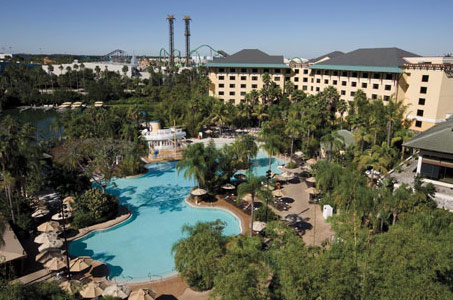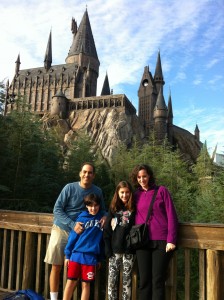Over President’s Day weekend, my wife and I decided it was time to have some fun in the warmth and sunshine of Florida, so we made plans to take our two kids to Orlando.
But which park? Sure, Disney was the safe bet. But we all had been to Disney, but never to Universal. Now that our kids were 13 and  almost 10, it seemed that they had outgrown the Disney princesses and Pixar Cars and were ready for the more adult characters of Universal.
almost 10, it seemed that they had outgrown the Disney princesses and Pixar Cars and were ready for the more adult characters of Universal.
So we booked flights and hotels to Orlando and bought tickets to Universal Studios.
We ended up having very a fun and memorable 4 days. Yet, as a marketer, I could not help but observe some of the clear marketing techniques that Universal used to draw visitors to their park and to maximize the dollars spent there.
Here is some of what I saw:
1. Disney is a powerhouse brand; Universal is not in the same league. Instead of investing billions to try to match Disney’s brand, Universal partners with an existing super brand (worth billions) that appeals to its customers.
During 2000-2009, Disney was crushing Universal in terms of Orlando amusement goers. Disney was the clear #1, and Universal a
distant #2. Universal was the place you went if you had an extra day in Orlando.
But in 2010, Universal partnered with JK Rowling to open the Wizarding World of Harry Potter. Universal was brilliant to associate its park with such a powerful brand that appeals to its customer base.
And this partnership changed the game in Orlando.
Had there not been that Harry Potter section of the park, I am not sure we would have traveled to Orlando solely for Universal. We would have thought Universal was like another Six Flags park.
But with all of the positive comments we heard about the Wizarding World of Harry Potter, we felt that there was indeed wisdom in planning a focused trip to Universal.
Lesson: Businesses are wise to associate themselves with very powerful brands that appeal to their target audiences. The right partnership can change the game.
2. Segment your audience and set prices accordingly
There are hoards of visitors in the Parks (you see them in the lines!). But Universal knows they are willing to pay different amounts for ride tickets.
Consider the basic Universal ticket: a one-day, single-park pass costs about $82. At this level, you wait in the full lines that snake back-and-forth (perhaps a 45 minutes wait on average). My guess is 80-90% of the visitors buy these tickets.
 Then there is the Express ticket which puts Express holders in much shorter lines (perhaps 10 minutes per ride). This ticket requires a premium of $50-$110/day (above the $82 entry fee) depending on the season. This group is probably 10-20% of the park attendees. Note: a few very popular rides are excluded from the Express tickets to be fairer to the general ticket holders.
Then there is the Express ticket which puts Express holders in much shorter lines (perhaps 10 minutes per ride). This ticket requires a premium of $50-$110/day (above the $82 entry fee) depending on the season. This group is probably 10-20% of the park attendees. Note: a few very popular rides are excluded from the Express tickets to be fairer to the general ticket holders.
And for those visitors who cannot wait even 10 minutes Universal offers a VIP tour. Here a tour guide walks a small group to the front of every line. Of course, there is a premium- about $170/person on top of your $82 admission ticket.
This package is clearly targeted at the group who has both high disposable income and little patience.
The great benefit of such segmentation is that you maximize revenues and give people what they want.
Lesson: Understand your customer’s needs (skipping lines) and charge accordingly.
3. Two smaller parks bring in more revenue than one big park
Universal built two parks. Yet they are very close; just a 5 minute walk from one another.
Why not build one park with one set of gates? It would cost less to maintain staffers at one gate, right? This approach is fairly typical at places like Cedar Point or Hershey Park.
Nope. When you have two parks, you can sell premium tickets to gain admittance into both parks on the same day. In fact, the multiple-park passes sell for 50% more than single-pass tickets.
Did we fall for this multi-park premium? Of course, we want variety each day. One park is not enough; we needed two.
Lesson: Structure your products in a way to collect more revenue
4. Bundle your premium products with special perks
Universal has 3 beautiful on-site hotels that are in walking distance to the parks.

First class hotel comes with great perks.
- Everyone who stays in a hotel room gets the Express Pass for free (remember its value of $50-$110/ticket)
- Hotel guests can enter the Harry Potter section of the Park an hour early. So they get a jump on the other Park visitors. This extra hour of small crowds is precious for us Type A personalities.
This deal is actually quite appealing from the consumer perspective (I would recommend it to all visitors). We spent a lot on the hotel and tickets, but we got a lot of valuable perks in return.
Lesson: bundle your products together into a highly valuable (if pricey) offering
So I have shared with you some of the marketing lessons I saw expertly utilized by Universal Studios. As a professional I must say I was impressed.
But most importantly, as my family boarded our Southwest plane back home, I reflected that our 4-day trip to Orlando with my family was a ton of fun.
And as Arnold Schwarzenegger, who is featured in a Terminator ride at Universal, said, “I’ll be back.”

